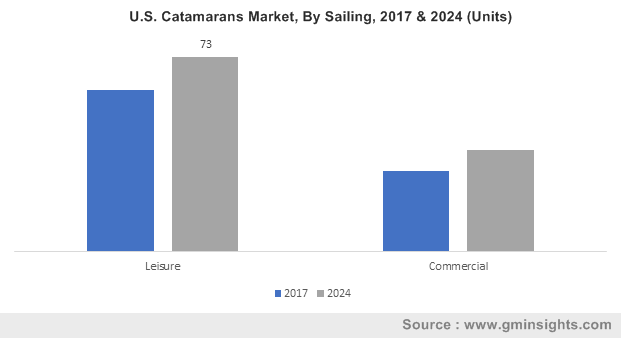U.S. catamaran market to witness phenomenal proceeds over 2018-2024, defense and sporting applications to fuel the demand
Publisher : Fractovia | Published Date : 2018-06-21Request Sample
With accelerated expenditure on recreational & tourism activities, the global catamaran market is gaining momentum in conjunction with sailing, campaigning, cruising and other water-based escapades. Derived from the rising disposable income levels, the increased fervor to undertake exploration trips has given a prolific impulsion to the catamaran market size.
Enhanced comfort, ample space, better structural integrity and sturdiness inspired the advent of multi-hulled designs as alternatives to the monohulled yachts and cruises, stimulating the worldwide catamaran industry. More commonly employed by the upper-class segment, catamarans are well suited for long distances allowing for a speed of over 20 nautical miles and better fuel efficiency, subsequently proving ideal for leisure use.
U.S. Catamarans Market, By Sailing, 2017 & 2024 (Units)

Innovations in technology pertaining to lightweight materials has enabled the manufacturing of vessels having stronger structure, high reliability, more weight-carrying capacity and motion stability. According to statistics released by the U.S Coast Guard, in 2015 there were over 4,100 accidents in the country which included 626 deaths. Subsequently, safety of the passengers has an utmost precedence and the catamarans industry offers vessels that are known to be less prone to accidents and sinking.
Equipped with several advantageous features over monohulled vessels, the catamaran market attracted a remuneration of around USD 1.5 billion in 2017 with powered catamaran being the largest contributor. The segment has profited owing to the rising demand for faster engine powered boats having improved speed and efficiency in comparison to the monohulled boats. Powered catamarans also allow for excellent maneuverability with smooth turning and are useful in cruising, ferrying, coastal surveillance and military transport applications. Further boosting the catamaran industry is the growing participation in sailing sport events like the America’s Cup, where Sailing catamaran can generate 20-50% more speed than mono-hulls of the same lengths.
Citing the catamarans market trends from defense sector, a segment which is slated to grow at 3.3% CAGR over 2018-2024, the U.S. Navy has deployed several shallow-draft catamarans in their expeditionary fast transport fleet. These vessels- having a substantial tonnage capacity, seats for 312 armed forces personnel and even more passengers, will join fleets around the globe for military cargo transport and rescue missions alike. With other countries adopting multihulled ships for similar purposes and added offence capabilities, revenue prospects for the catamaran market are widespread.
According to the public data available on Statista’s website, over 87 million adults in the U.S. participate in recreational boating activities, including fishing and water skiing. Factoring in the large customer base and surging economic power, the U.S. catamaran market size is anticipated to cross 567 units by 2024. The industry penetration is supported by the windward ability and wide deck surface designs that promise safe, comfortable experience. The vessels permit better all-round view while sailing or at anchor and the double-hull design also accommodates vast living spaces with more privacy.
Industry experts impose that catamarans are very difficult to capsize even in challenging weathers and are also ideal for shallow areas as they require lesser water to float. As catamarans are supposed to be faster than monohulled boats of similar dimensions, they can be expected to outrun storms. These features have made the market quite lucrative in Europe where the vessels can be used to tour the countless island destinations. Nonetheless, the interest of wealthy business tycoons and tremendous gush of and tourists in countries like Spain, Italy & Greece have spiked the popularity of sailing and power boat sports.
Further elaborating on the above, F18 European championships by a resort in Spain encourages the use of 18-foot two-person catamaran for competing to win multiple races. Other competitions like M32 Series covers most of European Mediterranean coast promote the sale of advanced M32 catamaran. Such events catch the attention of water sports enthusiasts and rotate the revenue chain of the catamaran industry.
To signify the potential of the Europe segment, the catamaran market in the region amassed an estimated USD 801.3 million in 2017, where France accounted for a dominating 60% production share. Germany and Italy are also well-known for catamaran production and cater to a variety of commercial, local and tourist population. Apart from the European countries, there are specialized production of catamaran in other parts of the world, such as Australia and South Africa which are focused on developing regional markets.
Over the past couple of decades engineers have meticulously studied and found solutions to a myriad of problems in catamarans making them more seaworthy and practical. Boat builders are investing towards developing advanced vessels for various transport applications to attract customers. Due to their budding popularity, catamaran have a better resale value than their monohulled counterparts.
Overall, the catamaran industry consists of a large number of players including Lagoon, Fountaine Pajot, Catana Group, Robertson & Caine, WorldCat, Outremer Yachting, LeisureCat, Alumarine Shipyard, etc.